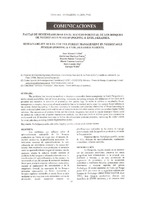Pautas de sustentabilidad en el manejo forestal de los bosques de Nothofagus pumilio (Poeppig & Endl.) Krasser
Sustainability rules for the forest management in Nothofagus pumilio (Poeppig & Endl.) Krasser forests
Date
2005-12-01Author
Cellini, Juan Manuel
Martínez Pastur, Guillermo José
Vukasovic, Ricardo Fabián
Lencinas, María Vanessa
Díaz, Boris Gastón
Wabö, Enrique
Metadata
Show full item recordAbstract
Los problemas que influyen sobre el aprovechamiento sustentable de los bosques productivos en Tierra del Fuego son: el descarte de material productivo, la planificación inexistente, los deficientes sistemas de aprovechamiento, la sub utilización del rendimiento potencial y la escasez del recurso. Para resolver estos problemas, es necesario hacer un aprovechamiento integral del recurso, siendo necesario adaptar la industria forestal existente al producto de los bosques y reformular alternativas en la planificación del aprovechamiento de los mismos. Se recomienda el uso del sistema de extracción mediante fustes para producir mayores volúmenes maderables, mejorar el rendimiento del motosierrista y de la maquinaria forestal. La conversión de los bosques primarios intervenidos en forma incompleta a bosques regulares manejados se puede llevar a cabo mediante la tala rasa (con o sin retención) o cortas de protección, siendo importante respetar las planificaciones realizadas en los planes de manejo aprovechando toda la superficie productiva, evitando la fragmentación. The problems that have to be resolved to develop a sustainable forest management in South Patagonia are: timber stands availability, lack of forest planning, inadequate harvesting systems, sub utilization of the stand yield potential and rejection in sawmills of productive low quality logs. In order to achieve a sustainable forest management a complete harvesting of wood possibility has to be reached and to adapt the existent forest industry to the present forest log quality. It becomes necessary to formulate new planning alternatives of forest harvesting in order to obtain higher stand yields and the use of complete stem extraction system, which can produce higher timber volumes. The conversion of primary forests and the already irregularly harvested, to regular managed forests could be carried out with several proposed regeneration methods, like clear cuts (with or without green tree retention) or shelterwood cuts. It becomes necessary to follow the silvicultural planning proposed, harvesting the timber stands for every site class, avoiding system fragmentation policy. Key words: Nothofagus pumilio, site index, logging systems, volume yield, timber volume.
Collections
- Revista Yvyraretá [360]
The following license files are associated with this item:




